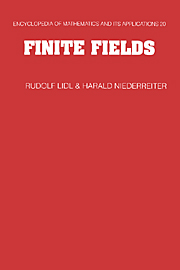Book contents
- Frontmatter
- Contents
- Foreword
- Preface
- Chapter 1 Algebraic Foundations
- Chapter 2 Structure of Finite Fields
- Chapter 3 Polynomials over Finite Fields
- Chapter 4 Factorization of Polynomials
- Chapter 5 Exponential Sums
- Chapter 6 Equations over Finite Fields
- Chapter 7 Permutation Polynomials
- Chapter 8 Linear Recurring Sequences
- Chapter 9 Applications of Finite Fields
- Chapter 10 Tables
- Bibliography
- List of Symbols
- Author Index
- Subject Index
Chapter 1 - Algebraic Foundations
Published online by Cambridge University Press: 02 November 2009
- Frontmatter
- Contents
- Foreword
- Preface
- Chapter 1 Algebraic Foundations
- Chapter 2 Structure of Finite Fields
- Chapter 3 Polynomials over Finite Fields
- Chapter 4 Factorization of Polynomials
- Chapter 5 Exponential Sums
- Chapter 6 Equations over Finite Fields
- Chapter 7 Permutation Polynomials
- Chapter 8 Linear Recurring Sequences
- Chapter 9 Applications of Finite Fields
- Chapter 10 Tables
- Bibliography
- List of Symbols
- Author Index
- Subject Index
Summary
This introductory chapter contains a survey of some basic algebraic concepts that will be employed throughout the book. Elementary algebra uses the operations of arithmetic such as addition and multiplication, but replaces particular numbers by symbols and thereby obtains formulas that, by substitution, provide solutions to specific numerical problems. In modern algebra the level of abstraction is raised further: instead of dealing with the familiar operations on real numbers, one treats general operations —processes of combining two or more elements to yield another element—in general sets. The aim is to study the common properties of all systems consisting of sets on which are defined a fixed number of operations interrelated in some definite way—for instance, sets with two binary operations behaving like + and · for the real numbers.
Only the most fundamental definitions and properties of algebraic systems—that is, of sets together with one or more operations on the set—will be introduced, and the theory will be discussed only to the extent needed for our special purposes in the study of finite fields later on. We state some standard results without proof. With regard to sets we adopt the naive standpoint. We use the following sets of numbers: the set ℕ of natural numbers, the set ℤ of integers, the set ℚ of rational numbers, the set ℝ of real numbers, and the set ℂ of complex numbers.
GROUPS
In the set of all integers the two operations addition and multiplication are well known.
Information
- Type
- Chapter
- Information
- Finite Fields , pp. 1 - 46Publisher: Cambridge University PressPrint publication year: 1996
